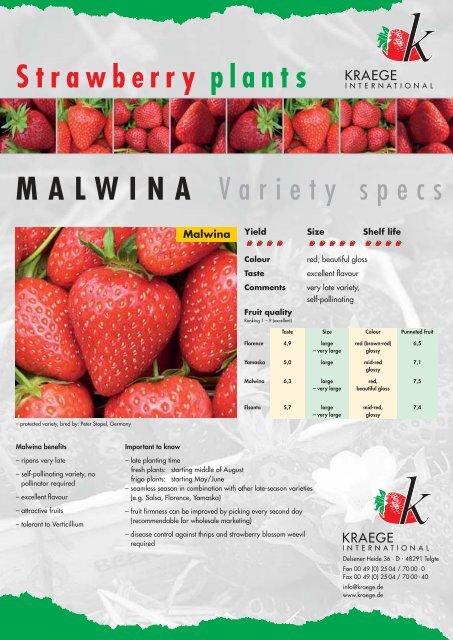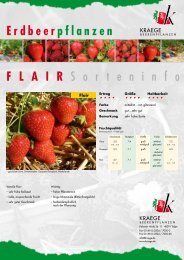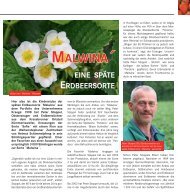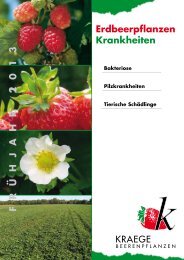MALWINA Variety specs Strawberry plants - Kraege.de
MALWINA Variety specs Strawberry plants - Kraege.de
MALWINA Variety specs Strawberry plants - Kraege.de
Create successful ePaper yourself
Turn your PDF publications into a flip-book with our unique Google optimized e-Paper software.
<strong>Strawberry</strong> <strong>plants</strong><br />
KRAEGE<br />
INTERNATIONAL<br />
<strong>MALWINA</strong> <strong>Variety</strong> <strong>specs</strong><br />
– protected variety, bred by: Peter Stopel, Germany<br />
Malwina benefits<br />
– ripens very late<br />
– self-pollinating variety, no<br />
pollinator required<br />
– excellent flavour<br />
– attractive fruits<br />
– tolerant to Verticillium<br />
Important to know<br />
Malwina Yield Size Shelf life<br />
Colour red; beautiful gloss<br />
Taste excellent flavour<br />
Comments very late variety,<br />
self-pollinating<br />
Fruit quality<br />
Ranking 1 – 9 (excellent)<br />
– late planting time<br />
fresh <strong>plants</strong>: starting middle of August<br />
frigo <strong>plants</strong>: starting May/June<br />
– seamless season in combination with other late-season varieties<br />
(e.g. Salsa, Florence, Yamaska)<br />
– fruit firmness can be improved by picking every second day<br />
(recommendable for wholesale marketing)<br />
– disease control against thrips and strawberry blossom weevil<br />
required<br />
Taste Size Colour Punneted fruit<br />
Florence 4,9 large red (brown-red) 6,5<br />
– very large glossy<br />
Yamaska 5,0 large mid-red 7,1<br />
glossy<br />
Malwina 6,3 large red, 7,5<br />
– very large beautiful gloss<br />
Elsanta 5,7 large mid-red, 7,4<br />
– very large glossy<br />
KRAEGE<br />
INTERNATIONAL<br />
Delsener Hei<strong>de</strong> 36 · D - 48291 Telgte<br />
Fon 00 49 (0) 25 04 / 70 00 -0<br />
Fax 00 49 (0) 25 04 / 70 00 -40<br />
info@kraege.<strong>de</strong><br />
www.kraege.<strong>de</strong>
<strong>MALWINA</strong> Geschützte Sorte, Sorteninhaber Darbonne<br />
The new late-season variety<br />
Malwina is the latest ripening among the<br />
currently available strawberry varieties worth<br />
growing. It is going to set new standards for<br />
late season varieties in the direct marketing<br />
segment. Already un<strong>de</strong>r standard cultivating<br />
conditions, the peak season is some 22 days<br />
after Elsanta (12 days after Florence). When<br />
straw covering is applied it ripens as late as<br />
about 30 days after Elsanta!<br />
Malwina is a crossbred of ‘Sophie’ x a clone<br />
from Schimmelpfeng, Weihenstefan. The<br />
crossbreeding was done in 1998 by Peter<br />
Stoppel, Kressbronn. The plant is very robust<br />
and vigorous, with dark green, medium<br />
sized, glossy leaves. Malwina blooms un<strong>de</strong>r<br />
the foliage and is self-pollinating.<br />
The berries are large, firm and feature a<br />
glossy mid red. When picked pale red (wholesale<br />
marketing), their flavour is good – and<br />
excellent when picked fully ripe. Malwina is<br />
a pleasure to the eye, in the basket as well as<br />
Yield progress<br />
Elsanta<br />
0% 50% 100%<br />
Florence<br />
in the punnet. Its aroma reminds us of “strawberries<br />
from grandma’s gar<strong>de</strong>n”, as a customer<br />
put it.<br />
Yields for Malwina are about 10 – 15% lower<br />
than that of Elsanta (and about 20% lower<br />
when straw covering is applied). The percentage<br />
of large fruits is 85% (about 77% with<br />
straw covering). That means the proportion<br />
of marketable Class 1 fruits is higher than<br />
with Elsanta. The picking rate is between 10<br />
and 15% lower, though, due to the short<br />
pedicels and the ample foliage.<br />
Given the vigorous growth, late planting is<br />
recommendable. Nitrogen fertiliser should be<br />
applied very carefully, <strong>de</strong>pending on the climate<br />
and soil (too vigorous growth will significantly<br />
reduce the picking rates). About 3%<br />
of the fruits feature so called “leaved inflorescences”.<br />
The genetic <strong>de</strong>fect behind causes<br />
small leaves emerging from the fruits on<br />
about one fruit per plant.<br />
Picking periods, Trial at <strong>Kraege</strong>/Telgte<br />
Malwina<br />
KRAEGE<br />
INTERNATIONAL<br />
1st June 25th 1 July<br />
st July<br />
1 2 3 4 5 6 7 8 9 10 11 12 13 14 15 16 17 18 19 20 21 22 23 24 25 26 27 28 29 30 1 2 3 4 5 6 7 8 9 10 11 12 13 14 15 16 17 18 19 20 21 22 23 24 25 26 27 28 29 30 31 1<br />
Elsanta<br />
887<br />
613<br />
Class 1<br />
274<br />
Malwina – covered with straw<br />
Florence<br />
1169<br />
984<br />
Class 1<br />
185<br />
Malwina<br />
Yield in g:<br />
756<br />
640<br />
Class 1<br />
117<br />
Malwina <strong>de</strong>layed season<br />
Total<br />
> 30 mm<br />
< 30 mm<br />
669<br />
511<br />
Class 1<br />
158<br />
Malwina is very hardy and resistant to diseases.<br />
For example, it is tolerant to Verticillium,<br />
very little susceptible to fruit rot, and highly<br />
or even fully resistant to mil<strong>de</strong>w. Malwina<br />
withstands intense rain and is little susceptible<br />
to sunburn.<br />
Important note:<br />
Disease control against strawberry<br />
blossom weevil and thrips required!!!








